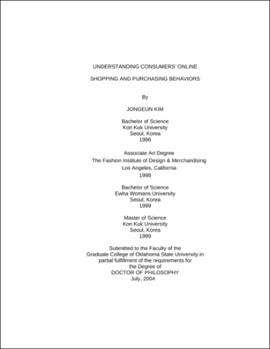| dc.contributor.advisor | Muske, Glenn | |
| dc.contributor.author | Kim, JongEun | |
| dc.date.accessioned | 2013-11-26T08:23:22Z | |
| dc.date.available | 2013-11-26T08:23:22Z | |
| dc.date.issued | 2004-07 | |
| dc.identifier.uri | https://hdl.handle.net/11244/6700 | |
| dc.description.abstract | Scope and Method of Study: The purpose of this study was to examine individuals that had completed an Internet purchase and compared them to other Internet shoppers and browsers. | |
| dc.description.abstract | The exploratory study examined the differences among non-web shoppers, web-store visitors with no intention of purchasing, Internet browsers with an intention to purchase and Internet buyers. The comparison was made based on a theoretical model derived in part from Fishbein and Ajzen's "Theory of Reasoned Action" (1980) and Cowles, Kieker, and Little's "E-tailing Theory" (2002) and a comprehensive literature review. The model identified the theoretical factors anticipated to influence the four groups and their level of online shopping. | |
| dc.description.abstract | Two hundred sixty-six college students in Oklahoma served as purposive research samples. Using Cronbach's alpha scores, the reliability and validity of the hypothesized factors was examined. To identify if Internet buyers differed from non-buyer in terms of demographic characteristics, computer and Internet use and/or experience, attitude toward the Internet shopping and online purchasing intention, thirteen hypotheses were proposed and analyzed using chi-square, t-tests, ANOVA, and logistic and linear regression. | |
| dc.description.abstract | Findings and Conclusions: Profiles of each of the four groups of online consumers, Internet buyers, Internet browsers, web-store visitors, and non-web shoppers, were developed. Significant differences in terms of marital status, number of credit cards hold, hours of Internet use and primary use of Internet were found. Also the items that comprised the consumer factor were significant in not only who intended to make a purchase online but also who actually completed the transaction. To increase online sales, e-retailers would find it helpful to consider the results of this study, understanding however that it represents only a small, purposive sample. Internet retailers should provide convenience, secure transactions, and a complete description as well as ample visual presentations of merchandise. Retailers should also provide an enjoyable atmosphere in order to make Internet shopping advantageous over other retail outlets. Result of the study suggest that successful e-tailers will respond to the individual needs of each group if they desire to move them through the stages of non-shoppers to buyers. | |
| dc.format | application/pdf | |
| dc.language | en_US | |
| dc.rights | Copyright is held by the author who has granted the Oklahoma State University Library the non-exclusive right to share this material in its institutional repository. Contact Digital Library Services at lib-dls@okstate.edu or 405-744-9161 for the permission policy on the use, reproduction or distribution of this material. | |
| dc.title | Understanding consumers' online shopping and purchasing behaviors | |
| dc.contributor.committeeMember | Jin, Byoungho | |
| dc.contributor.committeeMember | Yu, Hong | |
| dc.contributor.committeeMember | Kelsey, Kathleen D. | |
| osu.filename | Kim_okstate_0664D_1049 | |
| osu.accesstype | Open Access | |
| dc.type.genre | Dissertation | |
| dc.type.material | Text | |
| dc.subject.keywords | consumers | |
| dc.subject.keywords | online | |
| dc.subject.keywords | shopping | |
| dc.subject.keywords | purchasing | |
| thesis.degree.discipline | Design, Housing and Merchandising | |
| thesis.degree.grantor | Oklahoma State University | |
